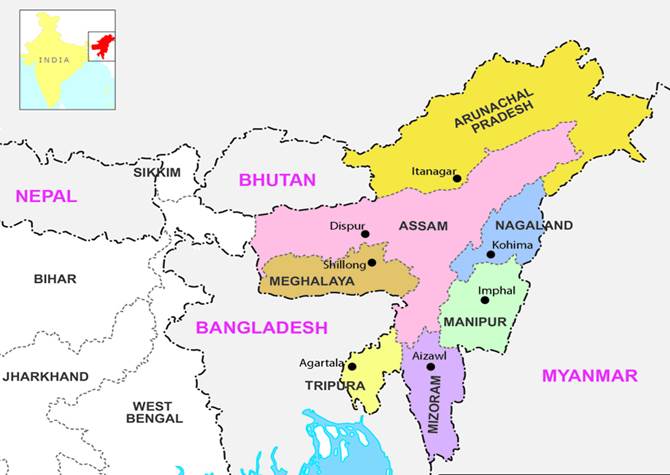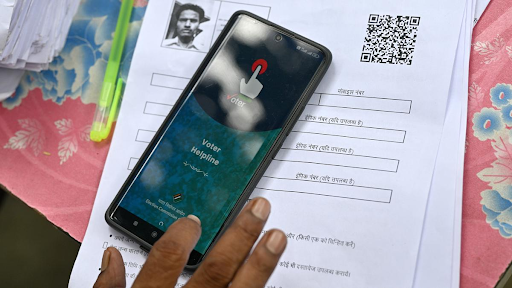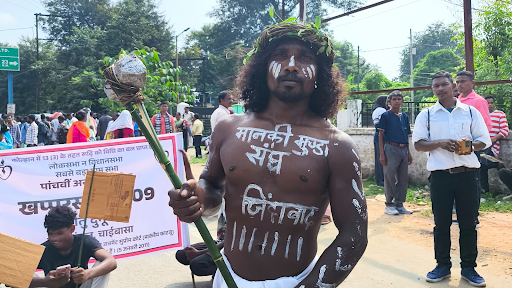Description

Copyright infringement not intended
News
- Nagaland celebrated its 60th statehood day on 1st December. It became the 16th Indian State on 1st December 1963.
About Nagaland
- Nagaland is a landlocked state in the northeastern region of India.
- It is bordered by;
- Arunachal Pradesh in the North.
- Assam in the West.
- Manipur in the South
- Myanmar in the East.
- Its capital city is Kohima and its largest city is Dimapur.
- Rhododendron is the state flower.
- Blyth's Tragopan is the State Bird of Nagaland.
- Nagaland is a mountainous state. It is home to a rich variety of natural, cultural and environmental resources.
- Nagaland has a largely monsoon climate with high humidity levels.
- The evergreen tropical and subtropical forests are found in strategic pockets in the state.
- Ntangki National Park, Pulie Badze Wildlife Sanctuary, Fakim Wildlife Sanctuary and Rangapahar Reserve Forest are some nature reserves in Nagaland.
- The state is also known as the "falcon capital of the world."
- Mithun (a semi-domesticated gaur) is the state animal of Nagaland and has been adopted as the official seal of the Government of Nagaland.
- The state has significant resources of natural minerals, petroleum, and hydropower with agriculture as the state's most important economic activity, accounting for over 70% of its economy.
- Other significant activities include forestry, tourism, horticulture, cottage industries, etc.
- The state has experienced insurgency and inter-ethnic conflict since the 1950s, limiting its economic development.
.jpg)
Nagaland Insurgency
- History
- The British annexed Assam in 1826, and in 1881, the Naga Hills too became part of British India.
- The first sign of Naga resistance was seen in the formation of the Naga Club in 1918, which told the Simon Commission in 1929 “to leave us alone to determine for ourselves as in ancient times”.
- In 1946 came the Naga National Council (NNC), under the leadership of Angami Zapu Phizo, declared Nagaland an independent state on August 14, 1947.
- The NNC resolved to establish a “sovereign Naga state” and conducted a “referendum” in 1951, in which “99 per cent” supported an “independent” Nagaland.
- On March 22, 1952, Phizo formed the underground Naga Federal Government (NFG) and the Naga Federal Army (NFA). The Government of India sent in the Army to crush the insurgency and, in 1958, enacted the Armed Forces (Special Powers) Act.
- On November 11, 1975, the government got a section of NNC leaders to sign the Shillong Accord, under which this section of NNC and NFG agreed to give up arms.
- A group of about 140 members led by Thuingaleng Muivah, who was at that time in China, refused to accept the Shillong Accord and formed the National Socialist Council of Nagaland in 1980. Muivah also had Isak Chisi Swu and S S Khaplang with him.
- In 1988, the NSCN split into NSCN (IM) and NSCN (K) after a violent clash. While the NNC began to fade away, and Phizo died in London in 1991, the NSCN (IM) came to be seen as the “mother of all insurgencies” in the region.
- Peace Efforts
- On June 29, 1947, Assam Governor Sir Akbar Hyderi signed a 9-point agreement with moderates T Sakhrie and Aliba Imti, which was almost immediately rejected by Phizo.
- The Naga Hills, a district of Assam, was upgraded to a state in 1963, by also adding the Tuensang Tract which was then part of NEFA.
- In April of the next year, Jai Prakash Narain, Assam Chief Minister Bimala Prasad Chaliha and Rev. Michael Scott formed a Peace Mission and got the government and NNC to sign an agreement to suspend operations that September.
- But the NNC/NFG/NFA continued to indulge in violence, and after six rounds of talks, the Peace Mission was abandoned in 1967, and a massive counter-insurgency operation was launched.
- The demand for NSCN (IM)
- A “Greater Nagalim” comprising “all contiguous Naga-inhabited areas”, along with Nagaland. That included several districts of Assam, Arunachal and Manipur, as also a large tract of Myanmar.
- The map of “Greater Nagalim” has about 1, 20,000 sq km, while the state of Nagaland consists of 16,527 sq km.
- The claims have always kept Assam, Manipur and Arunachal Pradesh wary of a peace settlement that might affect their territories.
- The Nagaland Assembly has endorsed the ‘Greater Nagalim’ demand — “Integration of all Naga-inhabited contiguous areas under one administrative umbrella” several times.
- Recent government initiatives
- Muivah, Swu and other top NSCN (IM) leaders escaped to Thailand in the early 1990s.
- While Nagaland Governor M M Thomas, a Church leader from Kerala, extracted the first positive response from the NSCN (IM), Prime Minister P V Narasimha Rao met Muivah, Swu and others in Paris on June 15, 1995.
- In November 1995, then MoS (Home) Rajesh Pilot met them in Bangkok. Subsequently, Prime Minister H D Deve Gowda met them in Zurich on February 3, 1997, which was followed by meetings with officers in Geneva and Bangkok.
- Prime Minister Atal Bihari Vajpayee met them in Paris on September 30, 1998. The Government of India signed a ceasefire agreement with NSCN (IM) on July 25, 1997, which came into effect on August 1, 1997.
- Over 80 rounds of talks between the two sides were held subsequently.
- The Modi government continues from where Vajpayee left off.
- The state’s political scenario has changed, with T R Zeliang’s Naga People’s Front, an NDA ally, persuading all groups in the Assembly, including the Congress, to become partners in an all-party government.
- Framework Agreement 2015
- The 2015 Framework Agreement between the Centre and the National Socialist Council of Nagalim (Isak-Muivah) to finalise the Naga Peace Accord is now turning out to be the key stumbling block in reaching an agreement between the two sides and finding a permanent solution to the longstanding Naga issue.
- The vague wording of the Framework Agreement and the Centre's belligerent stand on issues of separate constitution and flag for any region in the country after August 5, 2019 decisions on J&K have pushed the Naga Peace process into a stalemate. Even an apparent effort to mollify NSCN(IM) by removing former Naga interlocutor R N Ravi does not seem to have worked for the government.
.jpg)
https://pib.gov.in/PressReleasePage.aspx?PRID=1880125
https://t.me/+hJqMV1O0se03Njk9













